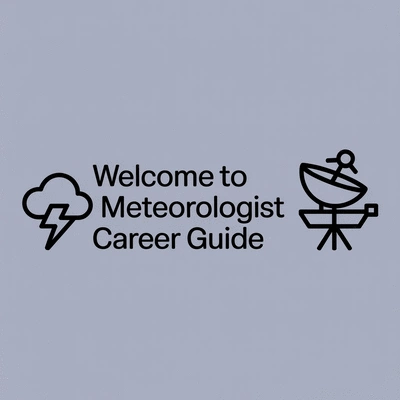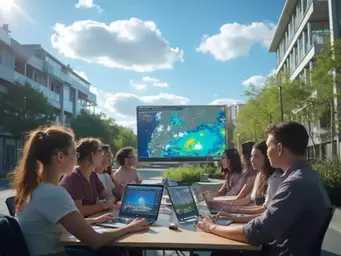As you contemplate a career in meteorology, consider this: engaging with real-world weather data through hands-on training can significantly enhance your understanding and employability in this dynamic field.
What You Will Learn
- Hands-on meteorology training is essential for bridging the gap between theory and practical application.
- Practical experience, such as internships and fieldwork, is crucial for enhancing job readiness and employability in meteorology.
- Top Australian universities offer programs that combine theoretical knowledge with practical training to prepare students for successful careers.
- Networking opportunities through professional organizations and conferences can provide valuable connections in the meteorology field.
Key Components of Hands-on Meteorology Training
Hands-on meteorology training involves three crucial components that bridge theoretical knowledge with practical application. These components are essential for aspiring meteorologists to develop real-world skills.
Understanding Hands-on Meteorology Training in Australia
As someone deeply passionate about weather science, I believe that hands-on meteorology training is key to developing the skills necessary for a successful career in this field. This type of training allows students to engage directly with real-world data, tools, and methods, making the learning experience much more impactful. In Australia, numerous universities offer programs that emphasize practical experience alongside theoretical studies, equipping aspiring meteorologists to tackle the challenges of their future careers.
In essence, hands-on meteorology training bridges the gap between theory and practice. It involves various practical components, such as lab exercises, fieldwork, and internships, which are vital for students aspiring to understand weather patterns and forecasting techniques. If you're considering a career in meteorology, gaining this practical experience can set you apart from the competition!
What is Hands-on Meteorology Training?
Hands-on meteorology training refers to educational experiences that allow students to apply theoretical knowledge in practical, real-world settings. This can include working with advanced weather instruments, analyzing data sets, and even conducting research projects related to atmospheric phenomena. By engaging in these activities, students can enhance their understanding of fundamental meteorological concepts.
- Fieldwork: Gaining experience in outdoor settings where meteorological phenomena occur.
- Laboratory Work: Engaging in experiments and simulations to analyze weather patterns.
- Internships: Collaborating with industry professionals to gain insights into daily operations within meteorological organizations.
The combination of these experiences not only enriches students' understanding but also prepares them to face practical challenges in their future careers. This active learning approach is invaluable in fostering essential skills like data analysis and effective communication.
Importance of Practical Experience in Meteorology
Practical experience is crucial in meteorology as it enables students to apply their classroom learning to real-world situations. This hands-on approach promotes a deeper understanding of how weather forecasting works, which can greatly enhance a graduate's employability. For example, students who have participated in internships often find themselves more adept at utilizing meteorological software and tools.
- Real-World Application: Translating theoretical knowledge into actionable insights.
- Networking Opportunities: Building relationships with professionals in the field.
- Job Readiness: Gaining experience that makes graduates more attractive to potential employers.
As an advocate for aspiring meteorologists in Australia, I can attest to the positive impact that practical experience has on one's career trajectory. It empowers individuals to make informed decisions about their future and strengthens their confidence in tackling various meteorological challenges!
Top Universities Offering Practical Meteorology Courses
When considering pursuing a career in meteorology, it's essential to select a university that offers a practical approach to education. In this section, I’ll highlight some of the top universities in Australia that excel in providing hands-on meteorology training. Each institution focuses on blending theoretical knowledge with practical experience to ensure students are well-prepared for their future careers.
For instance, the University of Melbourne offers subjects like Dynamic Meteorology, which provides advanced theoretical and practical training in atmospheric dynamics and thermodynamics, crucial for understanding weather phenomena. Similarly, Monash University's Bachelor of Science program includes units such as Atmospheric Dynamics, which delves into the physical processes governing atmospheric motion and weather systems through both lectures and practical exercises.
Engage with the Meteorology Community!
Have you ever thought about how engaging with fellow meteorology enthusiasts can enhance your understanding of the field? Consider this:
Frequently Asked Questions about Hands-on Meteorology Training
Q: What is hands-on meteorology training?
A: Hands-on meteorology training involves educational experiences where students apply theoretical knowledge in practical, real-world settings through fieldwork, laboratory work, and internships.
Q: Why is practical experience important in meteorology?
A: Practical experience is crucial because it allows students to apply classroom learning to real-world situations, promoting a deeper understanding of weather forecasting, enhancing job readiness, and creating networking opportunities.
Q: What are the key components of hands-on meteorology training?
A: The key components include fieldwork (gaining experience in outdoor settings), laboratory work (engaging in experiments and simulations), and internships (collaborating with industry professionals).
Q: How can I stay connected with the meteorology community?
A: You can stay connected by joining professional organizations like the Australian Meteorological and Oceanographic Society, following industry news, and utilizing social media platforms to engage with professionals.
Q: What should I consider when choosing a meteorology program?
A: When choosing a program, consider the curriculum's hands-on components, faculty expertise, availability of internship opportunities, facilities and resources, and networking potential.
Concluding Thoughts on Choosing the Right Meteorology Program
As you embark on your journey toward a career in meteorology, it’s crucial to choose a program that aligns with your aspirations and learning style. With a variety of universities offering unique practical meteorology training courses across Australia, evaluating your options can feel overwhelming. Here are some key considerations to keep in mind:
- Program Curriculum: Look for programs that offer hands-on training and real-world applications.
- Faculty Expertise: Research the qualifications and backgrounds of the faculty members.
- Internship Opportunities: Consider programs that provide access to internships or fieldwork experiences.
- Facilities and Resources: Assess the availability of laboratories, equipment, and technology that enhance learning.
- Networking Potential: Explore how the program connects you with industry professionals and organizations.
These factors are essential in ensuring that your education is not only informative but also prepares you for the dynamic field of meteorology!
Final Recommendations for Pursuing Hands-on Meteorology Training in Australia
Based on my experience and insights from the Meteorologist Career Guide, I recommend diving into programs that emphasize practical training alongside theoretical knowledge. This combination is vital in developing the skills needed for a successful career in meteorology. When considering specific universities:
- Investigate their hands-on components in the curriculum.
- Connect with current students or alumni to gain firsthand insights into their experiences.
- Look for opportunities to engage with local meteorological organizations.
By taking these steps, you’ll be better equipped to make an informed decision that sets you on the path to success in this rewarding field!
Engaging with the Meteorology Community
How to Stay Connected with Industry Developments and Networking Opportunities
Staying engaged with the meteorology community is essential for your growth and professional development. Here are a few effective ways to remain connected:
- Join Professional Organizations: Becoming a member of organizations like the Australian Meteorological and Oceanographic Society can provide networking opportunities.
- Follow Industry News: Subscribe to meteorological journals and blogs to stay updated on research and advancements.
- Utilize Social Media: Engage with meteorology groups on platforms like LinkedIn to connect with professionals in the field.
By actively participating in these communities, you’ll gain valuable insights and establish relationships that may benefit your career!
Encouragement to Seek Out Practical Experiences and Internships
As you progress in your studies, I encourage you to seek out practical experiences and internships related to meteorology. Engaging in these opportunities can significantly enhance your understanding and application of weather science:
- Internships: Apply for internships at meteorological agencies, research centers, or private companies.
- Volunteer Opportunities: Get involved in community weather programs or outreach initiatives.
- Field Studies: Participate in fieldwork that allows you to apply your knowledge in real-world settings.
These experiences are invaluable for building your resume and gaining insights into the day-to-day operations of meteorologists!
Importance of Conference Participation and International Collaboration
Participating in conferences and events is a fantastic way to broaden your understanding of meteorology and connect with other professionals. Here’s why you should consider it:
- Knowledge Sharing: Conferences often feature leading experts sharing the latest research and techniques in meteorology.
- Networking: These events provide unique opportunities to meet professionals and establish connections that can lead to job opportunities.
- International Collaboration: Engaging with global meteorology communities can expose you to diverse perspectives and innovative ideas.
As you navigate your career path, remember that the meteorology community is vast and supportive. Embrace every opportunity to learn, connect, and grow!
Recap of Key Points
Here is a quick recap of the important points discussed in the article:
- Hands-on Training: Essential for bridging the gap between theoretical knowledge and practical application in meteorology.
- Real-World Experience: Engaging in fieldwork, lab exercises, and internships significantly enhances employability and understanding of meteorological concepts.
- Choosing the Right Program: Consider program curriculum, faculty expertise, internship opportunities, and networking potential when selecting a university.
- Community Engagement: Join professional organizations, follow industry news, and utilize social media to stay connected with the meteorology community.
- Seek Practical Experiences: Actively pursue internships, volunteer opportunities, and field studies to deepen your knowledge and skills.










